

The Hortus Sanitatis (also written Ortus; Latin for The Garden of Health), a Latin natural history encyclopaedia, was published by Jacob Meydenbach in Mainz, Germany in 1491.
It describes species in the natural world along with their medicinal uses and modes of preparation. It followed the Latin Herbarius moguntinus (1484) and the German Gart der Gesundheit (1485), that Peter Schöffer had published in Mainz. Unlike these earlier works, besides dealing with herbs, the Hortus sanitatis deals with animals, birds, fish and stones too. Moreover the author does not restrict himself to dealing only with real creatures, but also includes accounts of mythical animals such as the dragon, harpy, hydra, myrmecoleon, phoenix, and zitiron.
Author
The author is unknown. Occasionally the Frankfurt physician Johann Wonnecke von Kaub is incorrectly named as the author.
Contents
Set in two columns, the work contains five sections describing simple drugs used for therapy:
- De Herbis with 530 chapters on herbs.
- De Animalibus with 164 chapters on land animals (Chapter 1: De homo).
- De Avibus with 122 chapters on birds and other airworthy animals.
- De Piscibus with 106 chapters on aquatic animals.
- De Lapidibus with 144 chapters on semi-precious stones, ores and minerals.
- As appendix a treatise on uroscopy and several detailed registers.
Set in two columns, each chapter is headed by a picture. The following text gives a general description of the related simple drug and under the title of »oparetiones« a list of its effects on the human body.
The plants of the section "De Herbis" were determined by B. and H. Baumann (2010, pp. 205-222) according to current binominal nomenclature.
Sources
The author has composed the Hortus sanitatis out of well-known medieval encyclopaedias, such as the Liber pandectarum medicinae omnia medicine simplicia continens of Matthaeus Silvaticus (14th c.) and the Speculum natural of Vincent of Beauvais (13th century).
The text of uroscopy at the end of the Hortus sanitatis was borrowed from a text that circulated in numerous manuscripts under the names of »Zacharias de Feltris« or »Bartholomew of Montagna«.
A Latin manuscript, dated 1477, which already contains the textual core of Hortus sanitatis, was initially regarded as a possible template for the printing, but is now held for an independent copy of a Latin »circa-instans-manuscript«.
Publication history
Incunabule
- Mainz. Jacob Meydenbach (June 23) 1491
- Strasbourg. Anonymous 1496
- Strasbourg. Anonymous 1497-1498 (with woodcuts from the workshop of Johann Grüninger, which were also used to illustrate the Kleines Destillierbuch of Hieronymus Brunschwig (1500).
- Strasbourg. Anonymous 1499 (Johann Prüß der Ältere?)
- Paris. Antoine Vérard 1500 Ortus sanitatis translate de latin en françois
16th century
- Strasbourg after 1500 (with woodcuts from the workshop of Hans Grüninger).
- Venice (Bernhardinus Benalius and John de Cereto de Tridino) 1511 (4th reprint: Venice 1611); Reprint (in two volumes) Würzburg 1978.
- Strasbourg 1517
- Paris 1539 Phillipe le Noir Le jardin de santé
Sections two to five of the Hortus sanitatis (section one – herbs – lacking). Latin
- Strasbourg. Matthias Apiarius 1536
Sections two to five of the Hortus sanitatis (section one – herbs – lacking). German
- Straßburg 1529. Hans Grüninger
- Straßburg 1529. Balthasar Beck. Gart der gesuntheit. zu latin …
- Straßburg 1536. Mathias Apiarius. Gart der gesuntheit zů latein …
- Frankfurt 1556. Hermann Gülfferich. Gart der Gesundtheyt Zu Latein …
An English version of extracts from the Hortus, the Noble lyfe & natures of man, of bestes, serpentys, fowles & fisshes, was produced in 1491 by Laurence Andrew (fl. 1510–1537). A facsimile edition of this was published in London in 1954 by B. Quaritch.
Illustrations
The woodcut illustrations are stylised but often easily recognizable, and many were re-used in other works. In addition to the representations of simples, pictures show their use by humans, and scenes in which figures are surrounded by the subjects in their natural environment, such as standing by a river with fish and mermaids.
Illustrations. Mainz 1491
Source:
-
 Book I, chapter 43. ..... Arbor vel lignum vite paradisi
Book I, chapter 43. ..... Arbor vel lignum vite paradisi
-
 Book I, chapter 84. Butirum – Butter
Book I, chapter 84. Butirum – Butter
-
 Book I, chapter 153. Caseus – Cheese
Book I, chapter 153. Caseus – Cheese
-
 Book I, chapter 192. Fenum – Hay
Book I, chapter 192. Fenum – Hay
-
 Book I, chapter 221. Hauser vel hausor
Book I, chapter 221. Hauser vel hausor
-
 Book I, chapter 269. ..... Lac – Milk
Book I, chapter 269. ..... Lac – Milk
-
 Book I, chapter 275. Manna
Book I, chapter 275. Manna
-
 Book Buch I, chapter 276. Mandragora vir
Book Buch I, chapter 276. Mandragora vir
-
 Book I, chapter 277. Mandragora femine
Book I, chapter 277. Mandragora femine
-
 Book I, chapter 292. ..... Mel – Honey
Book I, chapter 292. ..... Mel – Honey
-
 Book I, chapter 298. ..... Mirra
Book I, chapter 298. ..... Mirra
-
 Book I, chapter 307. Narcissus
Book I, chapter 307. Narcissus
-
 Book I, chapter 382. Panis – Bread
Book I, chapter 382. Panis – Bread
-
 Book I, chapter 463. ..... Sapo – Soap
Book I, chapter 463. ..... Sapo – Soap
-
 Book I, chapter 484. ..... Thus – Frankincense
Book I, chapter 484. ..... Thus – Frankincense
-
 Book I, chapter 510. Vinum – Vine
Book I, chapter 510. Vinum – Vine
-
 Book I, chapter 529. Adam and Eve under the Arbor paradisi
Book I, chapter 529. Adam and Eve under the Arbor paradisi
-
 Titlepage of the chapter ... »De animalibus«
Titlepage of the chapter ... »De animalibus«
-
 Book II, chapter 1. ..... Homo – Human
Book II, chapter 1. ..... Homo – Human
-
 Book II, chapter 5. ..... Asinus – Donkey
Book II, chapter 5. ..... Asinus – Donkey
-
 Book II, chapter 119. Pediculus – Head louse
Book II, chapter 119. Pediculus – Head louse
-
 Book II, chapter 154. Vipera
Book II, chapter 154. Vipera
-
 Book II, chapter 155. Unicornus – Unicorn
Book II, chapter 155. Unicornus – Unicorn
-
 Titlepage of the chapter ... »De avibus«
Titlepage of the chapter ... »De avibus«
-
 Book III, chapter 91. ..... Ova – Eggs
Book III, chapter 91. ..... Ova – Eggs
-
 Titlepage of the chapter ... »De piscibus«
Titlepage of the chapter ... »De piscibus«
-
 Book IV, chapter 3. ..... Allec – Fish soup
Book IV, chapter 3. ..... Allec – Fish soup
-
 Book IV, chapter 56. ..... Mugil – Mullet
Book IV, chapter 56. ..... Mugil – Mullet
-
 Titlepage of the chapter ... »De lapidibus«
Titlepage of the chapter ... »De lapidibus«
-
 Book V, chapter 6. Allectorius – Stone in the liver of a Capon
Book V, chapter 6. Allectorius – Stone in the liver of a Capon
-
 Book V, chapter 12. Arena – Sand
Book V, chapter 12. Arena – Sand
-
 Book V, chapter 13. Argilla – Clay
Book V, chapter 13. Argilla – Clay
-
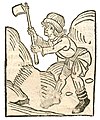 Book V, chapter 16. Bolus – Armenian bole
Book V, chapter 16. Bolus – Armenian bole
-
 Book V, chapter 18. Aurum – Gold
Book V, chapter 18. Aurum – Gold
-
 Book V, chapter 20. Argentum – Silver
Book V, chapter 20. Argentum – Silver
-
 Book V, chapter 21. Argentum vivum – Mercury
Book V, chapter 21. Argentum vivum – Mercury
-
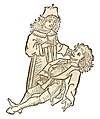 Book V, chapter 24. Bezaar – Bezoar
Book V, chapter 24. Bezaar – Bezoar
-
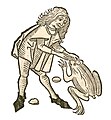 Book V, chapter 27. ..... Borax – Toadstone
Book V, chapter 27. ..... Borax – Toadstone
-
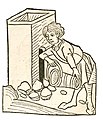 Book V, chapter 30. ..... Calx – Calcium oxide
Book V, chapter 30. ..... Calx – Calcium oxide
-
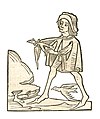 Book V, chapter 33. Celidonius – Stone in the stomac of swallows
Book V, chapter 33. Celidonius – Stone in the stomac of swallows
-
 Book V, chapter 35. Cerusa – White lead
Book V, chapter 35. Cerusa – White lead
-
 Book V, chapter 46. Cuprum – Copper
Book V, chapter 46. Cuprum – Copper
-
 Book V, chapter 101. Petroleum – Petroleum
Book V, chapter 101. Petroleum – Petroleum
-
 Book V, chapter 124. ..... Sal – Salt
Book V, chapter 124. ..... Sal – Salt
-
 Coulered copy
Coulered copy
-
 Book V, chapter 130. Terra sigillata
Book V, chapter 130. Terra sigillata
-
 Uroscopy
Uroscopy
-
 Physicians and patients
Physicians and patients
In culture
The University of Sydney comments that "The rich variety of the woodcuts makes this a very attractive book. The engraver was a skilled craftsman, but there is some botanical retrogression, since he did not always fully understand the plants he was copying from previous cuts."
A copy once owned by the apothecary George Pavius of Aberdeen is held by the University of Aberdeen.
References
Citations
- ^ Attenborough, David, "Ortus sanitatis", Cambridge Digital Library, retrieved 16 October 2014
- "Ortus sanitatis", Cambridge Digital Library, retrieved 16 October 2014
- Arber (1912), p. 28.
- Arber (1912), pp. 34–35.
- Matthaeus (Silvaticus) Moretus. Liber pandectarum medicinae omnia medicine simplicia continens. Bologna 1474 Bayerische Staatsbibliothek Matthaeus (Silvaticus) Moretus. Liber pandectarum medicinae. Straßburg ca. 1480 (Digitalisat)
- Vincentius. Speculum naturale. Straßburg 1481. Band I Bayerische Staatsbibliothek Band II (Digitalisat)
- Brigitte Baumann, Helmut Baumann: Die Mainzer Kräuterbuch-Inkunabeln – „Herbarius Moguntinus“ (1484) – „Gart der Gesundheit“ (1485) – „Hortus Sanitatis“ (1491). Wissenschaftshistorische Untersuchung der drei Prototypen botanisch-medizinischer Literatur des Spätmittelalters. Hiersemann, Stuttgart 2010,Spätmittelalters. Hiersemann, Stuttgart 2010, S. 182.
- Bartolomeo Montagna was a medical professor in Bologna and Padua, who died in 1460. --- Gundolf Keil: Montagna(na), Bartolomeo. In: Enzyklopädie Medizingeschichte. 2005, S. 1006.
- Gundolf Keil: ‚Hortus sanitatis‘. In: Enzyklopädie Medizingeschichte. 2005, S. 618.
- Jaques Rosenthal. Bibliotheca medii aevi manuscripta. Pars altera. Einhundert Handschriften des Mittelalters vom zehnten bis zum fünfzehnten Jahrhundert. Katalog 90. München 1928. Darin: Ernst Schulz. pp. V–VI: Vorwort (Digitalisat) and pp. 53–56 (No 146): Manuskriptbeschreibung (Digitalisat)
- Brigitte Baumann, Helmut Baumann: Die Mainzer Kräuterbuch-Inkunabeln – „Herbarius Moguntinus“ (1484) – „Gart der Gesundheit“ (1485) – „Hortus Sanitatis“ (1491). Wissenschaftshistorische Untersuchung der drei Prototypen botanisch-medizinischer Literatur des Spätmittelalters. Hiersemann, Stuttgart 2010,Spätmittelalters. Hiersemann, Stuttgart 2010, p. 182.
- Mainz. Jacob Meydenbach 1491 (digitized)
- Strasbourg. Anonymous 1497 (digitized)
- Baumann, Brigitte and Helmut: Die Mainzer Kräuterbuch-Inkunabeln. Hiersemann, Stuttgart 2010, S. 238–239.
- F. v. Zglinicki believed that this print could be attributed to the workshop of Johann Prüss (1447-1510). Friedrich v. Zglinicki: Die Uroskopie in der bildenden Kunst. Eine kunst- und medizinhistorische Untersuchung über die Harnschau. Ernst Giebeler, Darmstadt 1982, ISBN 3-921956-24-2, S. 60 f.
- Arber (1912), p. 35
- Strasbourg after 1500 (digitized)
- Strasbourg 1517 (digitized)
- Arber (1912), p. 36
- Strasbourg. Matthias Apiarius 1536 (digitized)
- Straßburg 1529. Hans Grüninger (Digitalisat)
- Straßburg 1529. Balthasar Beck. Gart der gesuntheit. zu latin … (Digitalisat)
- Straßburg 1536. Mathias Apiarius. Gart der gesuntheit Zů latein … (Digitalisat) (Digitalisat)
- Frankfurt 1556. Hermann Gülfferich. Gart der Gesundtheyt Zu Latein … (Digitalisat)
- "An early English version of Hortus sanitatis : a recent bibliographical discovery by Noel Hudson". NLA.gov.au. Retrieved 28 February 2016.
- "Johannes de Cuba Ortus sanitatis", Royal College of Physicians of Edinburgh, archived from the original on 21 October 2014, retrieved 16 October 2014
- Mainz. Jacob Meydenbach 1491 (digitized)
- "Treasures of the Rare Books and Special Collections Library: Scientific works: Hortus Sanitatis. Mainz: Jacob Meydenbach, 1491", University of Sydney, 17 September 2010, archived from the original on 11 December 2012, retrieved 28 February 2016
- The University of Aberdeen has a copy of "Hortius sanitas" owned by George Pavius (Georgius Pavius, 1596-1619). The book was also owned by Birney. AU ref Inc 3. Inscription: Magister Jacobus birny; Maist. Jameis birny. The item as the following inscription " ...Georgius pavius pharmacopoeus me iure possidet 1619 ex dono praepositi Abredonensis -- 1A1r. nunc ex dono praefecti Abredonensis anno 1619 die 20 martij datur Georgio pavio pharmacopoeo ; Georgius pavius pharmacopoeus me iure possidet 1619 -- 2E5v....".
Bibliography
- Arber, Agnes (1912). "The Hortus sanitatis". Herbals. Their origin and evolution. A chapter in the History of Botany 1470-1670. Cambridge University Press. pp. 25–34.
- Baumann, Brigitte and Baumann, Helmut: Die Mainzer Kräuterbuch-Inkunabeln – „Herbarius Moguntinus“ (1484) – „Gart der Gesundheit“ (1485) – „Hortus Sanitatis (1491).“ Wissenschaftshistorische Untersuchungen der drei Prototypen botanisch-medizinischer Leiteratur des Spätmittelalters.. Anton Hiersemann, Stuttgart 2010, pp. 177–222: Hortus sanitatis, Mainz, 23. Juni 1491 ISBN 978-3-7772-1020-9
- Fischer, Hermann. Mittelalterliche Pflanzenkunde. Verlag der Münchner Drucke, München 1929, pp. 94–109: Der große Hortus sanitatis (Mainz 1491)
- Raphael, Sandra (1986), "Herbal", in Goode, Patrick; Lancaster, Michael (eds.), The Oxford Companion to Gardens, Oxford University Press, pp. 249–252, ISBN 0-19-866123-1
External links
- Hortus Sanitatis (1485)
- Hortus Sanitatis Archived 2015-03-13 at the Wayback Machine (1491)
- Ortus Sanitatis published 23 June 1491. A copy with coloured illustrations in Cambridge Digital Library
- Ortus sanitatis 4th edition; 3rd Strasbourg edition. Published 1499 by J. Prüss in Strasbourg. Digitised copy in Boston Public Library
- Hortus sanitatis. Book IV. De Piscibus